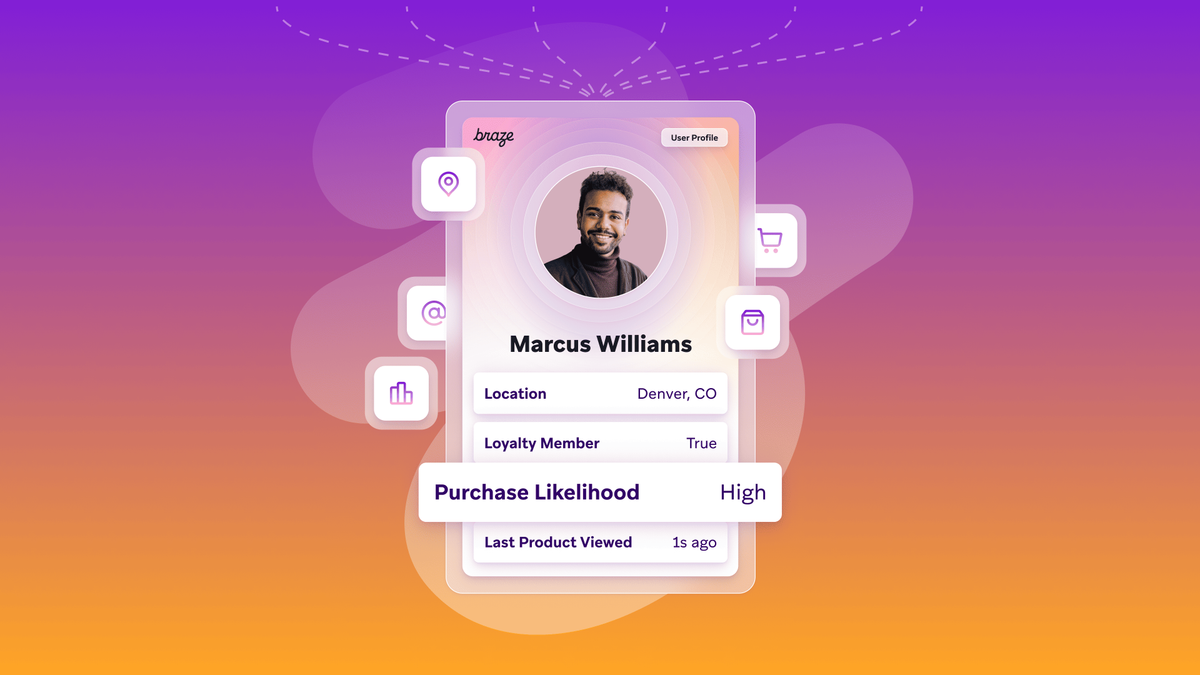How Brands Can Leverage Their Customer Data Source-of-Truth With Braze and Databricks Partnership
Published on June 26, 2023/Last edited on June 26, 2023/6 min read

Edwin Amador Artiles, Colleen Kerr, Jen McNamee, Alex Rees
Modern brands are managing an extraordinary amount of customer data. They’re also managing high customer expectations for rich, personalized experiences—making it more important than ever for that data to be actionable at a moment’s notice. To help brands more easily accomplish this feat, we’re excited to announce Braze Cloud Data Ingestion (CDI) for Databricks.
The Databricks Lakehouse Platform combines the best elements of data lakes and data warehouses to deliver the reliability, strong governance and performance of data warehouses with the openness, flexibility and machine learning support of data lakes. The scale of Databricks, when combined with the powerful AI of the Databricks Platform, makes it an ideal place to store, analyze and predict customer behavior, delivering that data to Braze to drive the desired actions and outcomes.
In this post, we’ll dive into the CDI and Databricks partnership, and how it can help teams reduce time-to-value, improve operations, and fuel more personalized (and valuable) customer experiences.
Reducing Time-to-Value With Braze and Databricks
It goes without saying that the deprecation of third-party cookies is changing how brands think about customer data. In just a few months, we’ve seen brands make huge shifts in how they prioritize zero- and first-party data in their strategies. While necessary, this change has uncovered a series of challenges for brands. A combination of deciding which data to collect (and often collecting too much), data being siloed across multiple teams, and how to deploy effective data management have resulted in making data actionable an increasingly difficult task.
At Braze, we hear the problem “we have a lot of data, and no way to make it quickly actionable” far too often. Our recommendation is, for the most part, that brands should have a source-of-truth for their data.
"We're excited to see Braze join the Databricks technology partner ecosystem. As the delivery of personalization and next generation customer experiences continues to be a top priority for every enterprise, the combination of the Databricks Lakehouse architecture and Braze's Customer Engagement Platform will be a game changer for our joint customers looking to deliver the very best in real time, 1:1 experiences." —Steve Sobel, Global Head, Communications, Media, & Entertainment GTM at Databricks
Cloud Data Ingestion allows customers to set up a direct connection from their data warehouse, in this case Databricks, to Braze and continuously sync their data as frequently as every 15 minutes. This integration makes sending additional user data as easy as updating a SQL query. In short, brands that want to leverage their customer data from Databricks can do so easily. Gone are the days of submitting engineering requests for customer data pulls, outdated .csv uploads to your engagement solution, and (more importantly) spending months waiting for your engineering team to implement middleware. With CDI, it’s a few minutes to set up your connection between Databricks and Braze, allowing teams to quickly capture the value of the data in their Databricks instance.
“I would say that our biggest win is the speed and throughput of CDI. What used to take us hours to process 250k records, Braze CDI can complete in mere minutes. We are seeing a roughly 20X improvement, utilizing out of the box functionality.” —Global freight transportation and logistics brand
How CDI Helps Improve Operations
Braze Cloud Data Ingestion allows you to set up a direct connection from your Data Warehouse to Braze to sync relevant user attributes, events, purchases, and user deletes. Once synced to Braze, this data can be leveraged for personalization, segmentation, and many other use cases. CDI’s flexible integration supports complex data structures including nested JSON and arrays of objects.
With CDI, teams can create a simple integration directly from their Databricks Instance to Braze in just a few minutes. Additionally, for teams like Risk and Compliance that are concerned with security, teams can securely sync user data, including attributes, events, and purchases from their Databricks Instance. Teams don’t have to worry about managing another SaaS solution, pipeline, or set of tools to provide marketers with customer data. The same solution that allows a marketer to engage with customers can now be seen as an extension of your Databricks, not another completely disparate tool.
“Cloud Data Ingestion has helped simplify our overall Braze data ingestion process. The process itself is straightforward and easy to implement. We were able to set up the process in one to two days, with most of the work being permissioning. We have saved a ton of time vs the more technical alternative of implementing API calls and Python scripts. Having a simpler ingestion process also makes documentation and handing off the process to others a much easier task. “ —Financial Services Brand
Better, More Valuable Personalization With CDI and Databricks
CDI was created for both the needs of marketers and technologists. For tech teams, this means decreasing the amount of marketing requests and automating data sharing processes so that technologists can focus on revenue generating projects. For marketers, this means having access to data that is always accurate and, more importantly, up-to-date.
It’s likely that we can all think of a time when we made a purchase and… then received a 10% discount. It’s a pretty frustrating experience. With CDI, you will be able to keep your data up-to-date—with sync times up to every 15 mins—so you’re not acting on old data and creating frustrating experiences for your customers.
Regardless of whether the data is an attribute, event, purchase, or external ID, you can trust that you’re reaching out to your customers with the same accurate data that your entire organization is working with. CDI enables a more complete view of your customer data for your entire organization.
Final Note
Braze helps brands activate data across their entire tech stack in order to leverage all customer data sources to form an accurate and complete customer profile. Our new and improved data offerings help reduce spend and technical debt, while improving data collaboration across multiple teams.
Forward-Looking Statements This post contains “forward-looking statements” within the meaning of the “safe harbor” provisions of the Private Securities Litigation Reform Act of 1995, including but not limited to, statements regarding anticipated product launches. These forward-looking statements are based on the current assumptions, expectations and beliefs of Braze, and are subject to substantial risks, uncertainties and changes in circumstances that may cause actual results, performance or achievements to be materially different from any future results, performance or achievements expressed or implied by the forward-looking statements. Further information on potential factors that could affect Braze results are included in Braze’s Annual Report on Form 10-K for the fiscal year ended January 31, 2023, filed with the U.S. Securities and Exchange Commission on March 31, 2023, and the other public filings of Braze with the U.S. Securities and Exchange Commission. The forward-looking statements included in this presentation represent the views of Braze only as of the date of this post, and Braze assumes no obligation, and does not intend to update these forward-looking statements, except as required by law.




